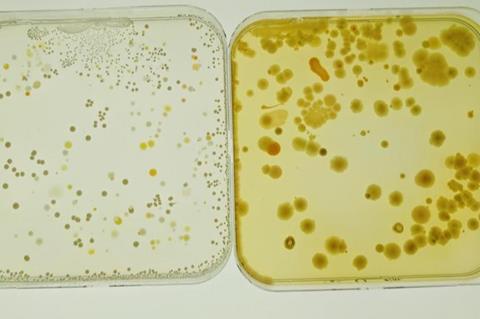An estimated 1,600 people in the U.S. contract a serious infection from Listeria bacteria in food each year and, of those individuals, about 260 people die, according to the Centers for Disease Control and Prevention.
Penn State researchers may now better understand how the bacterium, called Listeria monocytogenes, survives and persists in fruit-packing plants by evading and surviving sanitizers.

According to their study, which is now available online and will be published in the June issue of the journal Biofilm, biofilms — comprising otherwise harmless microorganisms that attach to each other and the food surface — result in a kind of shield that surrounds and protects the Listeria. The findings may result in changes to sanitation protocols in food-processing facilities that promise to diminish contamination of food with Listeria, the researchers said.
Security detail
“We found two groups of microorganisms in the tree fruit packing environments, Pseudomonadaceae and Xanthomonadaceae, that are very good at forming biofilms and protecting Listeria monocytogenes,” said corresponding author Jasna Kovac, the Lester Earl and Veronica Casida Career Development Professor of Food Safety.
“Biofilms represent a physical barrier that reduces the effective diffusion and antimicrobial action of sanitizers and is hypothesized to increase L. monocytogenes’ tolerance to sanitizers used in food processing facilities.”
As a result of the biofilms shielding the pathogen, the sanitizers are not as effective in killing Listeria monocytogenes, explained Laura Rolon, who recently earned her doctorate from Penn State and spearheaded the study.
“Our research suggests that if packing facilities are having a recurring problem with Listeria monocytogenes, they may need to assess whether biofilm-forming microorganisms are causing it,” she said.
Assessing sanitizers
This study’s results indicate a need to assess the efficacy of commonly used sanitizers against non-pathogenic biofilm-forming microorganisms commonly found in the food processing environments to prevent biofilms from establishing, Kovac explained. The results of further assessments could help inform practical recommendations for the industry, such as application concentrations and times, to prevent biofilm formation and improve the control of Listeria monocytogenes in these environments.
In future workshops and short courses, Penn State Extension educators will communicate the research findings to professional organizations dedicated to sanitation in food-processing facilities, noted study co-author Luke LaBorde, professor of food science and extension specialist.
“The findings of this research project will inform and enhance sanitation protocols and extension training efforts targeted at the tree-fruit industry to effectively control L. monocytogenes,” said LaBorde, an expert in the tracking of Listeria monocytogenes in produce production and processing environments. The bridge between scientific discovery and dissemination among stakeholders, he added, is a vital part of this work and a prime example of the mission of a land-grant university like Penn State.
Workshops for food industry
To that end, Penn State Extension routinely offers workshops and other resources to communicate research findings, such as the Listeria monocytogenes-biofilms study results, and promote other best practices for controlling foodborne pathogens. These trainings are typically attended by food-processing plant professionals, representatives of industry associations, food safety consultants and government inspectors.
Partially because of their research on Listeria monocytogenes and biofilms, Kovac and LaBorde won the Integrated Team Award from the College of Agricultural Sciences late last year.
Other co-authors include M. Laura Rolan, Olena Voloshchuk and Katelyn V. Bartlett, all with the Department of Food Science in the College of Agricultural Sciences at Penn State.
The U.S. Department of Agriculture supported this research.







No comments yet